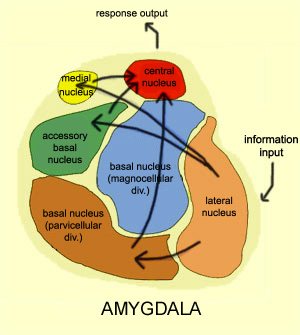|
|
|
|
 |
| Fear, Anxiety and Anguish |
 |
|
|
|


| Stimulating certain regions in the amygdala, such as the central nucleus, triggers physiological responses typically associated with fear. But the amygdala has other functions, as suggested by the fact that stimulation of other regions can produce a sensation of benign peacefulness, while the stimulation of still others can produce a towering rage! |
|
|
| THE CIRCUITS OF THE BODY'S ALARM SYSTEM |
|
 |
|
The
amygdala is a complex structure of the brain and has
about twelve sub-regions. Though not all of the regions
are involved in fear
reactions, many of them maintain connections that participate
in such reactions actively.
From experiments with lesions and
tracing of neural pathways, we now recognize the lateral
nucleus as the gateway into the amygdala. It is through
the lateral nucleus that the amygdala receives information
from the outside world. For example, in experiments with
fear conditioned by sounds, the stimulus that exits the
auditory thalamus enters the amygdala via the lateral nucleus. |
The structure through which information exits the amygdala has
also been clearly identified. It is the central nucleus,
which controls the bodily reactions associated with fear.
Within the amygdala, a number of internal pathways have been identified
by which information is routed from the lateral nucleus to the
central nucleus. There is one pathway that goes directly from the
lateral nucleus to the central nucleus.
The neurons of the lateral nucleus also project their axons to
several other, intermediate nuclei: the basal nucleus (with
its parvicellular and magnocellular divisions), the accessory
basal nucleus, and the medial nucleus. These structures
then relay the information to the central nucleus.
Each of these nuclei can be modulated by brain structures that
can influence the emotions, such as the hippocampus,
the frontal cortex, and the hypothalamus. Most of them can
also be subdivided into sub-regions whose connectivity also
appears to be very specific.
|
|





